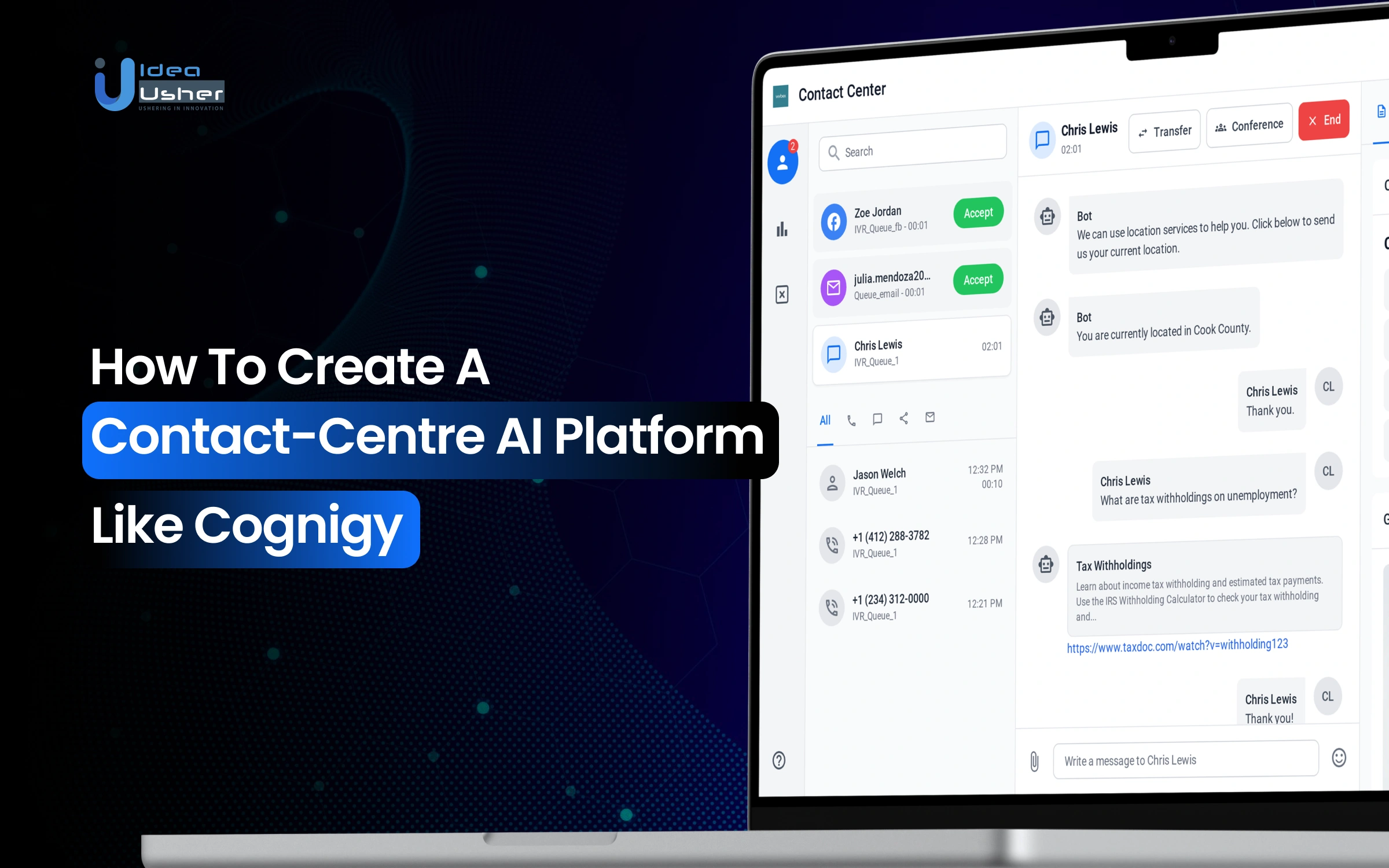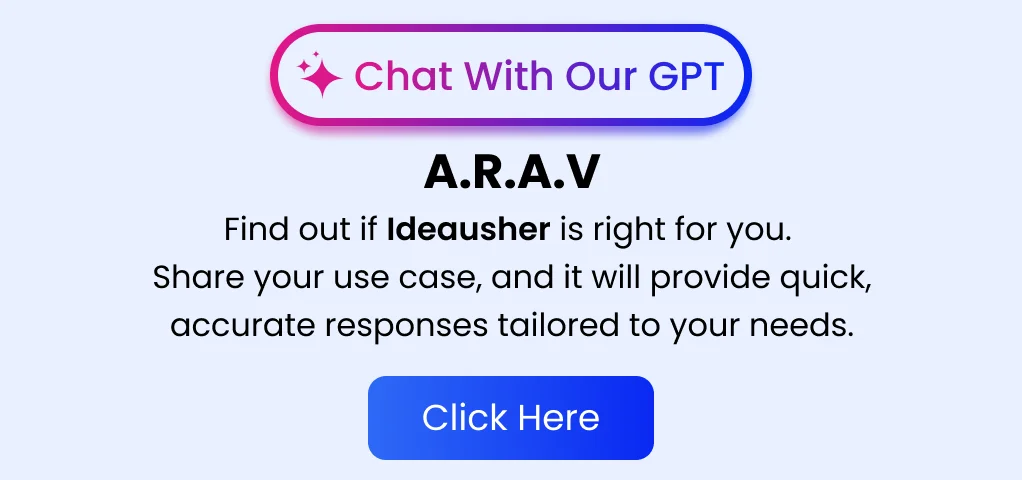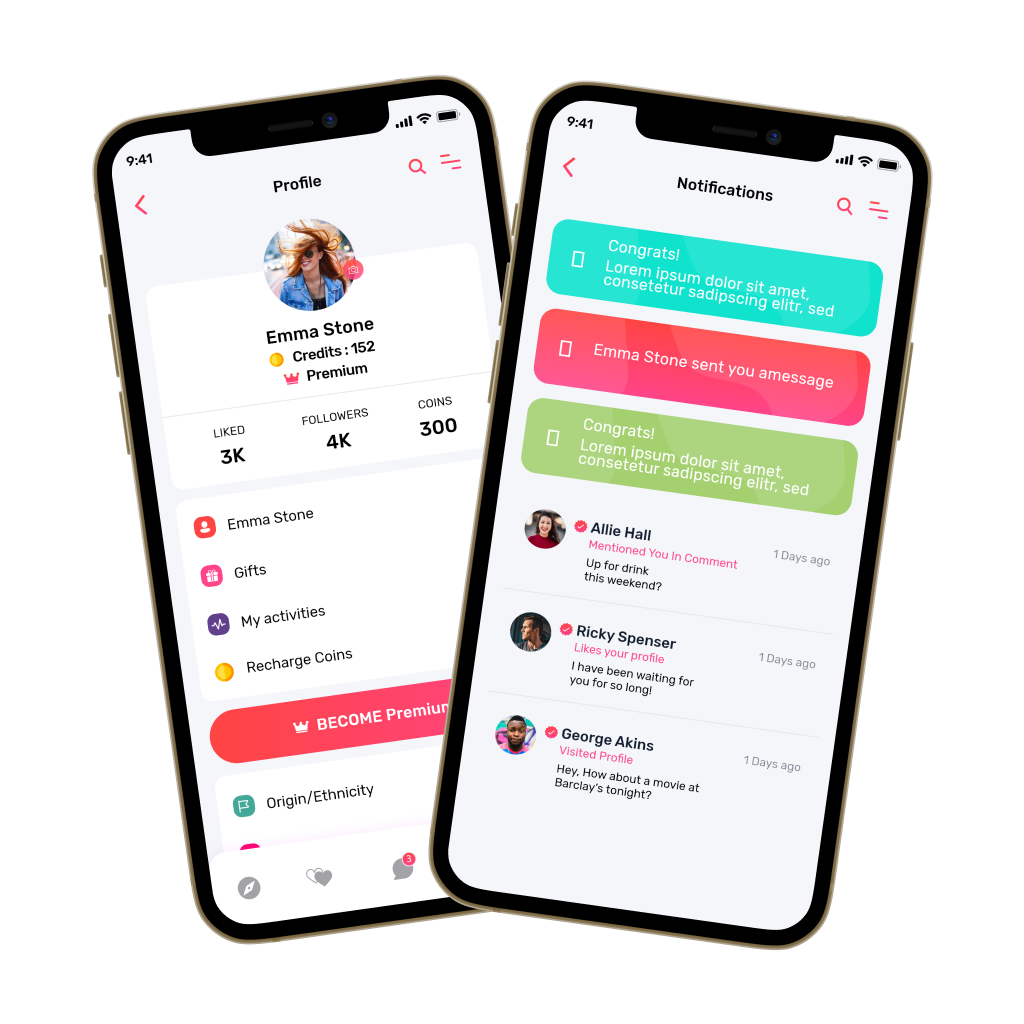Customer service has come a long way from long wait times and repetitive scripts. Businesses now need to respond faster and smarter to every query. A modern contact-centre AI platform like Cognigy can make that possible with intelligent automation. It can manage multilingual conversations across voice and chat channels with high accuracy. The system can integrate smoothly with CRMs and ticketing tools for unified workflows.
It may also analyze intent and sentiment to better understand customers. Real-time data processing helps agents make informed decisions during live interactions. Together, these capabilities turn ordinary support into a connected and adaptive experience.
Over the years, we’ve worked with many telecom providers and customer service-driven businesses, building several intelligent contact-centre solutions that use Conversational AI, NLP, and omnichannel orchestration frameworks. So, we’re writing this blog to share our expertise on the steps to build a contact-centre AI platform like Cognigy and understand its technical foundation.
Key Market Takeaways for Contact-Centre AI Platforms
According to GrandviewResearch, the global Contact-Centre AI market is experiencing strong momentum, valued at USD 1.99 billion in 2024 and expected to grow to USD 7.08 billion by 2030, at a 23.8% CAGR. This growth highlights how businesses are prioritizing AI-driven automation, personalization, and efficiency in customer support.

Source: GrandviewResearch
Companies are increasingly using intelligent virtual agents and self-service systems to reduce costs while delivering faster, more human-like customer interactions.
Industry leaders like Genesys AI and NICE Enlighten AI are setting high standards for innovation. Genesys AI enhances omnichannel engagement through predictive insights, while NICE Enlighten AI empowers agents with real-time behavioral analytics and coaching.
Both platforms help enterprises improve response times, satisfaction scores, and overall retention, demonstrating clear operational returns.
Partnerships are also shaping the market’s future. Five9’s collaborations with Zoom and Google Cloud showcase the power of combining cloud scalability with conversational intelligence, creating seamless integration across channels like voice, chat, and video. As AI becomes central to customer experience strategies, these collaborations are defining the next era of smarter, more connected contact centers.
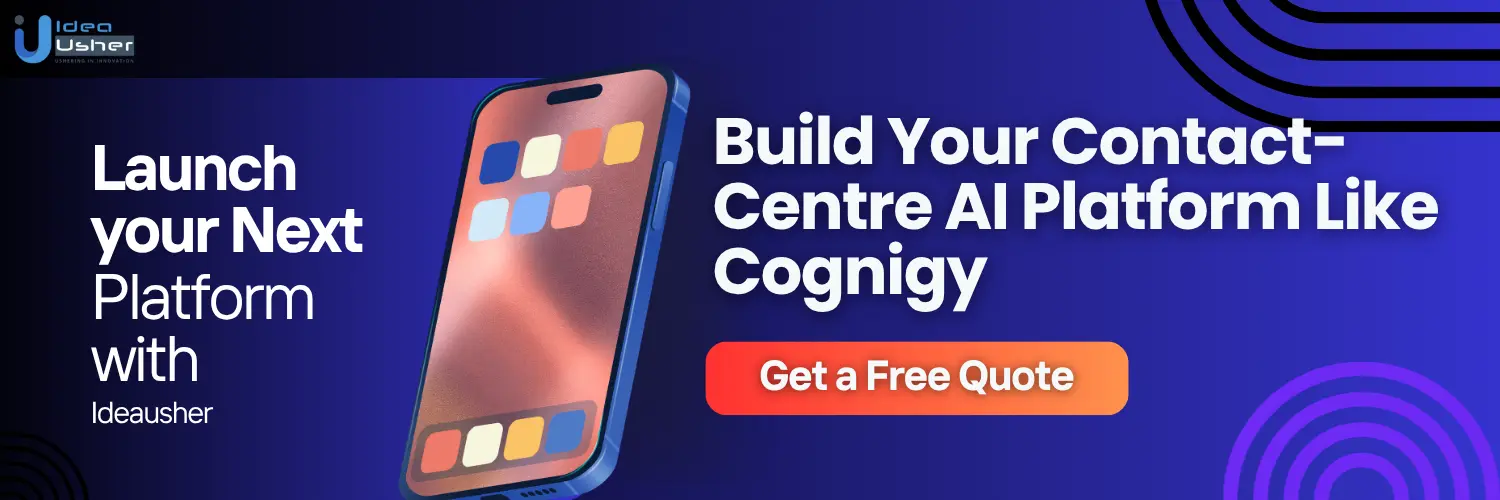
What is the Cognigy Platform?
The Cognigy Platform is an enterprise-grade conversational AI solution that enables organizations to design, deploy, and manage intelligent digital agents across voice, chat, and messaging channels. It helps businesses automate customer service with autonomous, goal-oriented agents that can reason, adapt, and make real-time decisions.
Powered by advanced LLMs, generative AI, and contextual memory, Cognigy.AI delivers natural, consistent, and effective interactions that enhance both customer and operational experiences.
Some of its key features are,
AI Ops Center
Cognigy’s AI Ops Center serves as a real-time command hub for managing enterprise AI operations. It offers full visibility into ongoing conversations, agent performance, and system health, helping businesses ensure service reliability and compliance at scale.
Advanced Automation
The platform supports more than 16 million automated interactions each year, handling tasks such as bookings, refunds, and account updates. Enterprises like E.ON, serving 50 million customers, achieve automation rates above 70% through Cognigy’s robust orchestration and AI management tools.
Generative & Multimodal AI
Cognigy enables natural, empathetic communication through generative AI and multimodal interfaces, spanning voice, chat, and beyond. Hyper-realistic voice agents and adaptive language models allow for seamless, human-like interactions that engage users across any touchpoint.
Real-Time AI Translation
With integrated real-time translation, customer service teams can support users in virtually any language. This capability removes language barriers, broadens global reach, and improves both accessibility and satisfaction.
Proactive Customer Support
Cognigy moves beyond reactive service by enabling proactive support, anticipating customer needs and offering solutions before issues arise. This drives higher engagement, better retention, and measurable revenue gains.
Knowledge AI & Generative Insights
Agents gain instant access to verified, contextual knowledge through Knowledge AI, reducing customer frustration and eliminating repetitive exchanges. Integrated generative tools surface relevant information dynamically, improving both speed and accuracy in support interactions.
Enterprise Scalability
Designed for high-volume environments, Cognigy scales effortlessly to handle millions of conversations and peak contact center loads. Its LLM orchestration layer ensures secure, efficient management across complex enterprise systems.
Omnichannel Engagement
From web chat and voice to in-car assistants and connected devices, Cognigy provides a consistent, frictionless experience across all customer channels.
How does the Cognigy Platform work?
The Cognigy platform combines a low-code builder, a hybrid AI engine, and real-time automation tools. It lets teams design and deploy intelligent agents that can reason, act, and respond naturally across voice or chat channels. The system can easily integrate with your existing tech stack, enabling precise, secure, and fast customer interactions.
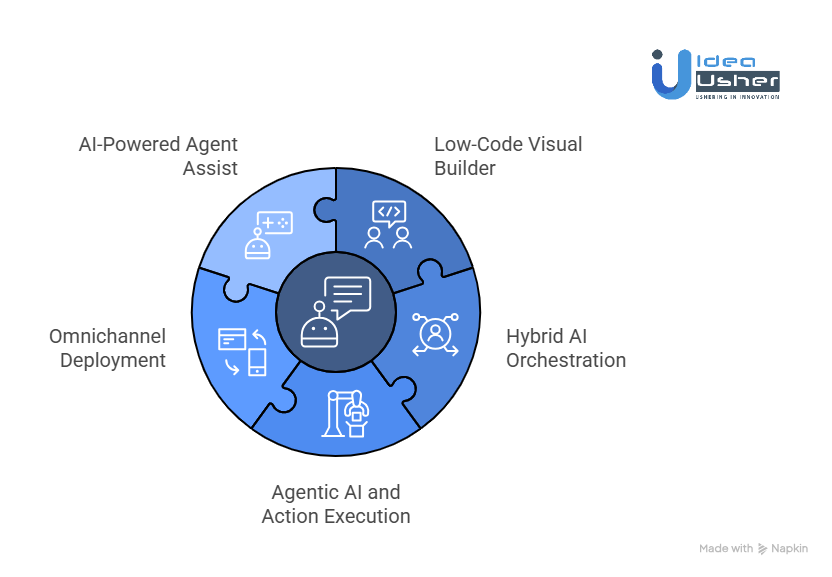
1. A Low-Code Visual Builder
At the core of Cognigy.AI is a visual, flow-based builder that allows teams across business and IT to design intelligent, automated conversations. It bridges the gap between technical developers and non-technical experts, enabling both to contribute directly to conversational design.
Flow Designer
Conversations are constructed by connecting “nodes” that represent messages, questions, API calls, and decision points. This visual interface lets designers map out dialogue logic that reflects real customer interactions while keeping it easy to update or expand.
Low-Code Actions
Common operations such as retrieving order data, checking customer records, or processing returns can be set up using secure, prebuilt integrations with backend systems. This minimizes custom coding and speeds up deployment.
This approach accelerates development cycles, improves collaboration between teams, and ensures complex automation logic remains transparent and scalable.
2. Hybrid AI Orchestration
Cognigy’s orchestration engine forms the platform’s decision-making core. It intelligently determines how to process each user input by combining deterministic logic and generative intelligence in a unified framework.
Think of it as a traffic controller for AI:
- When a user requests a task that must follow strict business rules, such as resetting a password or verifying identity, the engine routes the request through a secure, predefined workflow connected to enterprise systems.
- When the request involves an open-ended query, such as asking for feature details or product comparisons, the engine draws from a large language model (LLM) fine-tuned with company knowledge to deliver a precise, contextual answer.
This hybrid approach allows Cognigy to balance consistency and creativity, giving organizations the safety of structured automation alongside the adaptability of modern generative AI.
3. Agentic AI and Action Execution
Cognigy agents are not just conversational; they can take real actions. These agentic AI systems can reason through complex workflows, execute multi-step processes, and adapt dynamically to live data and results.
Each interaction follows a Reason–Act–Observe loop:
- Reason: The agent determines the steps required to fulfill a request, such as identifying the booking, checking availability, and calculating any additional cost.
- Act: It securely connects to relevant APIs or backend systems, including booking platforms or payment gateways, to complete those steps.
- Observe & Respond: The agent reviews the outcome, compiles the results, and communicates back to the user clearly and naturally.
By automating full customer journeys instead of isolated interactions, Cognigy enables measurable efficiency gains, faster resolutions, and significant cost savings.
4. Omnichannel Deployment
Cognigy agents are designed to operate consistently across multiple communication channels. Once an agent is built, it can be deployed instantly to:
- Voice and IVR systems
- Web and mobile chat interfaces
- Messaging applications such as WhatsApp, Microsoft Teams, and Slack
- SMS and other connected platforms
The platform maintains conversation context across every channel. This means a customer who starts a support interaction over the phone can continue seamlessly in a web chat without repeating information. The result is a connected, frictionless experience that meets users where they are.
5. AI-Powered Agent Assist
Cognigy integrates human support when needed through AI-powered Agent Assist, ensuring smooth transitions between digital and human interactions.
- Human agents instantly gain access to the entire chat or voice transcript, along with real-time context.
- The AI provides helpful suggestions, retrieves relevant articles or policy details, and can automatically summarize the conversation for recordkeeping.
This capability shortens handling times, reduces manual effort, and ensures customers receive consistent, informed service from both human and virtual agents working in sync.

What is the Business Model of the Cognigy Platform?
Cognigy.AI operates as a low-code platform that enables enterprises to design, deploy, and manage intelligent conversational agents across voice, chat, and messaging channels. These AI-driven agents automate high-volume customer service interactions, streamline routine workflows, and support human agents in real time.
The platform combines advanced NLU with Generative AI to handle complex dialogues, deliver context-aware responses, and adapt to user intent. Cognigy’s flexibility and scalability make it suitable for large-scale deployments across industries such as aviation, automotive, retail, and telecommunications. Major global clients include Lufthansa Group, Mercedes-Benz, Bosch, and Toyota.
Revenue Model
Cognigy’s business model is based on a subscription-driven Software-as-a-Service (SaaS) structure tailored for enterprise clients.
- License Subscriptions: Core platform access is offered through tiered enterprise licenses, typically starting at around $2,500 per month, depending on usage scale and customization needs.
- Usage-Based Billing: Revenue scales with the number of automated interactions, AI agent sessions, and the deployment of advanced capabilities such as real-time translation or generative AI modules.
- Professional Services: Additional income is generated through implementation, integration, and customization services that align Cognigy’s technology with client infrastructure, including CRM and contact center systems.
- Scalability and Upselling: As customers expand automation coverage, Cognigy monetizes increased AI workload and introduces value-added modules like Agent Assist and AI Ops Center for human-AI collaboration and operational control.
The acquisition by NiCE introduces a major growth lever: Cognigy can now cross-sell its automation platform into NiCE’s 1,000+ CXone enterprise customers, driving expansion without added channel costs or margin dilution.
Funding and Financial Performance
Cognigy has demonstrated strong financial momentum supported by strategic investment and accelerating market demand:
- In June 2024, the company raised $100 million in Series C funding, led by Eurazeo Growth, with participation from Insight Partners, DTCP, and DN Capital. The funds are allocated toward R&D in generative AI and global expansion.
- A prior Series B round raised $59 million, led by DTCP, marking early confidence in the platform’s scalability.
- Annual revenues grew from approximately $17.5 million in 2023 to an estimated $37 million in 2024, reflecting 111% year-over-year growth.
- Projections suggest $65 million in 2025 and $115 million in 2026, sustaining a strong compound annual growth trajectory.
In 2025, Cognigy was acquired by NiCE in a transaction valued at roughly $955 million, representing a forward revenue multiple of 8–14x, depending on future milestone performance. The acquisition aligns with NiCE’s broader CX strategy and leverages Cognigy’s AI capabilities to strengthen its enterprise automation suite.
NiCE’s Q2 2025 financials revealed 9% year-over-year revenue growth and a 25% rise in operating profit, underscoring a stable financial position that supports ongoing investment in AI technologies like Cognigy.
Market Positioning
Cognigy maintains a strong reputation as one of the top-ranked platforms in Gartner and Forrester evaluations for Conversational AI. It stands out through its focus on enterprise-grade orchestration, blending automation, human collaboration, and omnichannel engagement in one unified system.
The market for AI-first customer service is expected to reach $36 billion by 2032, positioning Cognigy to capture a significant share of enterprise automation spending. Its ability to integrate rule-based workflows with generative intelligence offers organizations a scalable path toward fully hybrid, AI-human customer experiences.
How to Develop a Contact-Centre AI Platform Like Cognigy?
We specialize in developing intelligent and scalable contact-centre AI platforms that transform how enterprises engage with their customers. Over the years, we’ve built several platforms like Cognigy for our clients, each tailored to their infrastructure and workflow needs. Our team designs every system with secure architecture and advanced conversational intelligence so it can adapt and perform reliably in real enterprise environments.
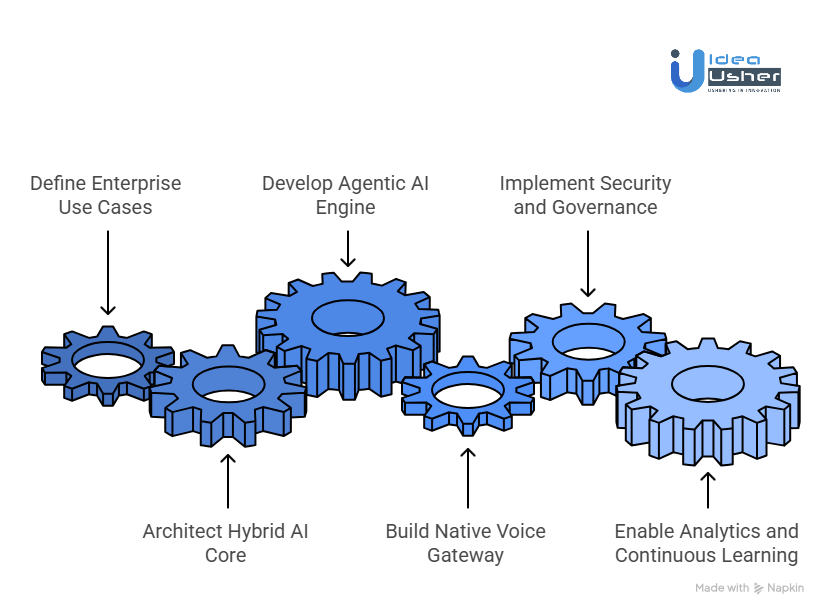
1. Define Enterprise Use Cases
We begin by mapping customer workflows across support, sales, and billing to uncover automation opportunities. Our compliance experts align the platform with GDPR, HIPAA, and SOC 2 standards. Each user journey is designed to deliver efficient, personalized, and compliant experiences.
2. Architect the Hybrid AI Core
Our hybrid AI core combines NLU precision with LLM flexibility. We design a routing layer that decides dynamically whether an intent is handled by NLU, RAG, or an LLM. Confidence scoring and modular flow logic ensure high accuracy and consistent performance across all conversations.
3. Develop the Agentic AI Engine
We build an agentic AI engine capable of autonomous reasoning and multi-step execution. A centralized Tool/Action Registry connects seamlessly with enterprise systems like CRM, ERP, and payments. Every action is logged for complete transparency and auditability.
4. Build the Native Voice Gateway
Our voice gateway uses low-latency streaming for real-time, natural conversations. With integrated STT/TTS and barge-in support, the system feels human-like. It connects effortlessly with Avaya, Genesys, and Twilio to deliver unified omnichannel experiences.
5. Implement Security and Governance
Security is built into every layer. We deploy PII masking, role-based access, and secure tokenization. LLM interactions are sandboxed to prevent data exposure, and compliance dashboards give administrators full visibility and control.
6. Enable Analytics and Continuous Learning
We track key metrics like agent performance, AI accuracy, and conversation success. Insights from analytics drive continuous improvement through fine-tuning and federated learning. Over time, the platform grows smarter and more aligned with business goals.
How Can a Contact-Center AI Platform Boost Bottom-Line?
When businesses consider deploying an enterprise-grade contact-center AI platform such as Cognigy, the conversation often gets stuck on cost. But the real story is not about what it costs to implement. It is about how much value it creates.
This technology does more than make customer service faster or cheaper. It transforms it into a strategic profit center, driving both top-line revenue growth and margin expansion. The following sections break down exactly how it impacts the financial metrics that matter most.
1. 24/7 Sales and Upsell
AI agents qualify leads, answer product questions, and make intelligent cross-sell or upsell suggestions based on a customer’s context and history.
For example, Talkdesk reports that AI-driven virtual agents can handle up to 80 percent of routine interactions. In a sales environment, that means the business continues generating revenue after human agents have finished for the day.
Example Calculation:
- After-hours contact volume: 10,000 per month
- Conversion rates: Human (5 percent), AI (2.5 percent)
- Average order value: $100
Incremental Revenue: 10,000 × 2.5% × $100 = $25,000 per month
Annualized: $300,000
That is $300,000 in additional annual revenue captured simply by remaining “open” when competitors are closed.
2. Cutting Handle Time and Expanding Capacity
Cognigy’s Agent Assist provides real-time prompts, scripts, and instant access to relevant knowledge. This reduces Average Handle Time and increases the number of customers each agent can support. Dialpad’s data shows that AI can reduce AHT by 10 to 20 percent.
Example Calculation:
- 200 agents, $25 per hour average cost
- AHT: 600 seconds reduced by 15 percent to 510 seconds
- Calls per agent per hour: from 6 to approximately 7
Financial Impact: 200 × $25 × 2,080 × 15% = $1,560,000 saved annually
This improvement represents a 15 percent increase in agent capacity, equivalent to adding 30 full-time employees without expanding payroll.
3. Call Deflection
Routine requests such as password resets, shipping updates, and balance inquiries are handled automatically, shifting interactions from costly voice channels to low-cost digital self-service. Dashly’s 2023 survey found that 74 percent of customers prefer chatbots for simple questions. That preference directly translates into measurable cost savings.
Example Calculation:
- Voice call cost: $8
- AI chat cost: $0.50
- Annual call volume: 500,000
- Deflection rate: 30 percent
Savings: 150,000 deflected calls × $7.50 = $1,125,000 annual savings
This represents more than one million dollars in savings, achieved by aligning service delivery with customer preference.
4. Customer Retention
Faster resolutions, continuous availability, and consistent service quality increase Customer Satisfaction and Net Promoter Score (NPS), which directly reduces churn.
Example Calculation:
- Annual revenue: $100 million
- Churn: 10 percent reduced to 9 percent
- Gross margin: 50 percent
Revenue retained: $100M × 1% = $1,000,000
Profit retained: $1,000,000 × 50% = $500,000
This is half a million dollars in additional profit, earned not through new sales but by retaining existing customers who continue to buy.
The Consolidated Financial Impact
| Metric | Annual Financial Impact |
| After-Hours Sales Revenue | $300,000 |
| Labor Cost Savings (AHT Reduction) | $1,560,000 |
| Operational Savings (Call Deflection) | $1,125,000 |
| Profit from Reduced Churn | $500,000 |
| Total Annual Impact | $3,485,000 |
The Investment and Payback
Implementing an enterprise-grade AI platform like Cognigy is a significant investment, often in the high six- to low seven-figure range for large-scale operations.
Even so, the payback period typically ranges from 12 to 18 months. Once operational, the platform continues to deliver recurring annual benefits that can exceed the initial investment by 3 to 5 times.
From a financial perspective, this is not a technology expense. It is a margin expansion initiative that directly strengthens profitability.

74% Customers Prefer Contact-Centre AI Platforms Over Human Agents
A recent survey revealed that 74% of customers would now choose a chatbot over a human agent for simple questions. This shift should not surprise anyone who has seen how quickly AI systems have advanced.
They can now respond faster, process data more accurately, and maintain consistency that human agents often struggle to match. Customers might still value empathy, but when it comes to routine queries, they simply want precision and speed. That is why many businesses have begun relying on contact-centre AI platforms to deliver faster, more consistent customer experiences.
1. Speed Has Become Non-Negotiable
In today’s instant world, waiting is unacceptable.
When a customer asks, “What’s my balance?” at 11 PM, AI provides the answer in seconds with complete accuracy. The human process involves navigating menus, verifying information, waiting on hold, and repeating the question.
For simple requests, people do not want a conversation; they want a resolution. AI delivers immediate results, and in a world that values time above all else, that matters.
2. 24/7 Availability
Customers live on their own schedule. Problems arise late at night, on weekends, or during holidays. Traditional call centers were never built for this reality, but AI is.
Modern AI systems never sleep. They deliver accurate, consistent support every hour of every day. The result is no downtime, no waiting, and no lost loyalty. Continuous availability has become the new baseline expectation.
3. Crushing the “Helper’s Hurdle”
The biggest frustration in customer support is the process itself: endless transfers, repeated explanations, and the sense that no one is really listening.
AI removes that pain entirely. It remembers every interaction, maintains full context, and never loses patience. Customers can pause a chat, return later, and pick up exactly where they left off. No repetition. No confusion. No wasted effort.
This is not just efficiency; it is empathy, delivered through precision.
4. The Zero-Effort Standard
Today’s consumers have been trained by brands like Amazon, Netflix, and Uber to expect seamless experiences. They want help without hassle and solutions without effort.
AI contact-center platforms now deliver exactly that. They anticipate customer intent, guide users through steps automatically, and complete transactions inside the same chat or voice session.
The new expectation is clear: zero effort, maximum convenience. Once customers experience it, anything less feels outdated.
5. The Shift in the Human Agent’s Role
AI is not replacing human agents; it is empowering them. When automation handles routine questions, human agents can focus on what truly needs empathy and emotional intelligence.
That leads to:
- More meaningful work for agents who solve complex, human-centered problems.
- Faster support for customers with urgent or intricate needs.
- Stronger relationships built through authentic human connection where it matters most.
AI handles efficiency. Humans handle emotion. Together, they create a service that is both intelligent and personal.
Key Challenges of a Contact-Centre AI Platform Like Cognigy
After working with many enterprises on conversational AI platforms like Cognigy, we’ve seen how the dream of a seamless AI contact centre can quickly meet technical reality. The road from idea to production is tricky and filled with hidden hurdles that teams often overlook. From our real-world experience, we can confidently show the key challenges and the proven ways to move past them effectively.
1. The Voice Latency Problem
In voice interactions, latency is the silent killer. A delay of even a second feels unnatural, breaking the flow of conversation and frustrating users. Achieving human-like responsiveness (under 500ms) is exceptionally difficult because the typical pipeline of Speech-to-Text, NLU, or LLM processing, and Text-to-Speech creates compounded delays at every step.
Our Solution
We design for speed from the ground up.
- Streaming, Not Batched: Our streaming STT begins transcribing audio as soon as the user speaks. This allows the NLU engine to start interpreting input before the user even finishes, saving critical milliseconds.
- Regional, Containerized Deployment: Centralized servers introduce latency. We deploy microservices in regional data centers using Kubernetes, ensuring low-latency processing close to the user.
- Predictive Preloading: For predictable conversation flows, we pre-load likely TTS responses to minimize the pause between speech and system reply.
Together, these optimizations make AI conversations feel fluid and human, not robotic or delayed.
2. The Control vs. Flexibility Dilemma
Large Language Models are brilliant for open conversation but unreliable for sensitive or deterministic tasks. Left unchecked, they can invent facts, break compliance rules, or mishandle secure workflows, which is unacceptable in a production contact centre.
Our Solution
We balance creativity with control through structured orchestration.
- Hybrid Routing: Our orchestration layer acts as a “traffic cop.” Routine, high-confidence intents such as “reset password” go to secure, rule-based flows, while open-ended questions are routed to the LLM.
- Context-Rich Prompts: We don’t use generic prompts. Every LLM instruction defines context, scope, and expected output to keep answers consistent and business-safe.
- Mandatory Action Validation: Before executing any API or transactional action, the system triggers a deterministic confirmation flow that adds an extra layer of safety and compliance.
This architecture ensures the LLM is powerful but never unpredictable.
3. The Legacy Integration Labyrinth
A conversational AI is only as valuable as the systems it can talk to. Yet most enterprises run on legacy CRMs, telephony platforms, or ERPs that were never designed for modern APIs. Building secure, real-time, bi-directional connections between these systems and an AI platform is one of the toughest parts of the journey.
Our Solution
Integration is not an afterthought. It is a core capability.
- Pre-Built Connectors: We maintain a library of adapters for popular CRMs, CCaaS platforms, and databases to shorten deployment timelines.
- Custom Middleware: For proprietary or aging systems, we build lightweight middleware that translates data and manages communication between back-end services and the AI layer.
- Centralized API Governance: All integrations flow through a secured gateway with rate limits, logging, and access controls to ensure reliability and compliance.
This approach transforms integration from a bottleneck into a scalable foundation.
4. Model Drift and Cost Volatility
The LLM landscape evolves monthly. A model that performs best today may be outdated or cost-prohibitive tomorrow. Vendor lock-in exposes enterprises to spiraling costs and technology risk.
Our Solution
We build AI platforms that stay adaptable.
- Abstraction Gateway: Our orchestration layer sits between business logic and model providers such as OpenAI, Anthropic, Gemini, or open-source models. The business logic never talks directly to an LLM vendor.
- Dynamic Model Switching: Depending on intent and complexity, the system routes requests to the optimal model, balancing cost and performance in real time.
- Failover and Future-Proofing: If one model fails or becomes obsolete, another takes over instantly. The platform stays current without a costly rebuild.
This keeps your AI strategy agile, cost-efficient, and resilient to the rapid evolution of generative AI.
Tools & APIs Need for a Contact-Centre AI Platform
Building a contact centre AI platform will require a solid mix of natural language systems, voice processing tools, and orchestration frameworks. You will need components that can understand intent, convert speech efficiently, and manage secure connections between services. The right setup should be modular and scalable so it can adapt quickly as models and technologies evolve.
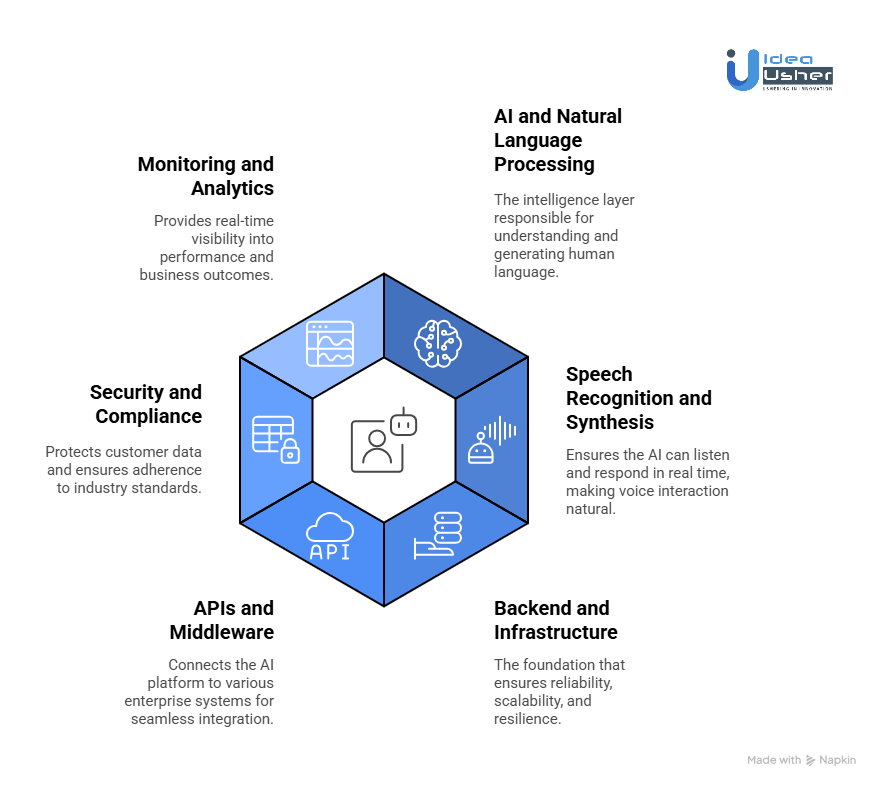
1. AI and Natural Language Processing
This is the intelligence layer that is responsible for understanding and generating human language.
Core NLU Engine
For intent recognition and entity extraction, solid options include Rasa (open-source and highly customizable) and Dialogflow CX (Google’s enterprise-grade platform). For clients needing complete control, we often develop custom Transformer-based models such as BERT variants, fine-tuned on domain-specific datasets.
LLM Orchestration
This is where modern reasoning and generative capabilities come in. APIs from OpenAI (GPT-4), Google Gemini, and Anthropic Claude are essential for conversational depth. You can also deploy local models such as Llama 3 for data privacy and cost control.
Our Insight: The right approach isn’t choosing one or the other. We build hybrid systems where the NLU handles deterministic, rule-driven interactions with full accuracy, while LLMs manage flexible, open-ended dialogues that require understanding and nuance.
2. Speech Recognition and Synthesis
Voice remains the most natural channel for human interaction, and this layer ensures that the AI can listen and respond in real time.
- Speech-to-Text: Providers like Deepgram and Google Speech-to-Text deliver high-accuracy, low-latency transcription. Look for features such as speaker diarization (distinguishing voices) and profanity filtering, which are essential in call environments.
- Text-to-Speech: The “voice” of your AI defines the customer experience. Tools like ElevenLabs, Google Wavenet, and Amazon Polly create lifelike, expressive speech that feels natural and engaging.
- Telephony Gateway: To connect to traditional phone systems, use APIs like Twilio Voice or Agora, which handle SIP trunking and real-time media streams, allowing your platform to focus on conversation logic instead of telephony complexity.
Our Insight: Low latency is everything in voice AI. We achieve this through streaming APIs for both STT and TTS, while co-locating our orchestration layer in the same regions as these services to minimize network lag.
3. Backend and Infrastructure
This is the foundation of the entire system and the layer that ensures reliability, scalability, and resilience.
Backend Runtime
The orchestration logic, responsible for state management, API calls, and business execution, can be built in Node.js (great for I/O-heavy workloads), Python with FastAPI (ideal for AI integration), or Java Spring Boot (for enterprise-grade reliability and complex workflows).
Containerization and Orchestration
Using Docker for packaging and Kubernetes (K8s) for orchestration has become the industry standard. It ensures high availability, horizontal scalability, and modular deployment.
Serverless Functions
For lightweight, event-driven tasks such as webhook processing or data transformation, AWS Lambda or Azure Functions offer excellent flexibility and cost efficiency.
4. APIs and Middleware
Your conversational AI is only as powerful as the systems it connects to. Integration is where most contact center projects succeed or fail.
- Enterprise Connectors: You’ll need secure, well-tested adapters to connect with systems like Salesforce, ServiceNow, Zendesk, or proprietary ERPs and databases.
- API Gateways: Gateways such as Kong or AWS API Gateway serve as a unified, secure entry point for backend communication, handling authentication, throttling, and request logging.
5. Security and Compliance
In the enterprise world, trust is everything. Security isn’t a layer to add later; it’s a foundation to build on.
- Authentication and Authorization: Use OAuth 2.0 and JWT (JSON Web Tokens) for secure identity management across services and users.
- Data Protection: Encrypt data both in transit (TLS) and at rest (AES-256) to protect customer information.
- Compliance Frameworks: Design for SOC 2, GDPR, and HIPAA compliance from the start. Include audit trails, access controls, and automatic masking of personally identifiable information.
6. Monitoring and Analytics
Once deployed, visibility becomes your greatest asset. This layer ensures that performance and business outcomes are always measurable.
Real-Time Dashboards: Tools like Grafana provide live visibility into operational metrics such as conversation volumes, intent accuracy, latency, and call durations.
Logging and Analysis: Platforms like the Elastic Stack or Datadog enable centralized logging, error detection, and trend analysis across your microservices.
Conclusion
Platforms like Cognigy are changing how enterprises view their contact centres by turning them into intelligent systems that can drive revenue instead of just handling calls. With hybrid orchestration and advanced reasoning, businesses can create scalable experiences that sound natural and still maintain full control. At Idea Usher we help companies design and deploy such platforms by combining strong conversational intelligence with reliable enterprise engineering that can evolve as their needs grow.
Looking to Develop a Contact-Centre AI Platform Like Cognigy?
At Idea Usher, we build intelligent Contact Centre AI Platforms that help businesses transform every customer interaction into a smarter, faster, and more human experience. We don’t just create software, we design systems that understand intent, automate workflows, and keep conversations seamless across every channel.
- With over 500,000 hours of coding experience, our team of ex-MAANG/FAANG developers knows exactly how to build systems that think, learn, and perform in real time.
- We design intelligent workflows that connect effortlessly with CRMs, telephony systems, and cloud infrastructure.
- Every build is engineered for reliability, flexibility, and enterprise-grade security—so your contact centre runs smarter, not just faster.
Check out our latest projects to see how we’ve helped brands bring next-gen AI communication to life.
Let’s build something that actually makes your contact centre intelligent.
Work with Ex-MAANG developers to build next-gen apps schedule your consultation now
FAQs
A1: Building a contact centre AI platform like Cognigy really depends on how complex your setup needs to be and how many systems you plan to connect. The total investment can vary based on the number of users, integrations, and automation layers you choose, but most enterprises treat it as a strategic build that scales with their customer operations and delivers strong ROI over time.
A2: A Contact Centre AI Platform is quite different from a basic chatbot because it goes beyond giving replies and starts handling reasoning, planning, and execution. It can manage multi-step workflows, pull data from various systems, and even make context-aware decisions, so it feels less like a simple responder and more like a digital operations brain.
A3: The platform can easily connect with legacy telephony and CRM systems through robust middleware APIs and enterprise connectors. You could link it with Avaya, Genesys, Salesforce, or Twilio without major structural changes, which makes integration smoother and keeps existing infrastructure useful for longer.
A4: Businesses can surely deploy it on premises when they need full control over their data and compliance environment. The architecture is flexible enough to run in cloud, on-prem, or hybrid models, letting teams adjust their deployment as operational needs evolve or as they plan to scale later.
